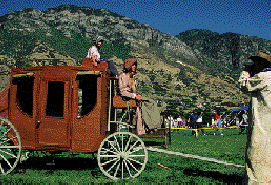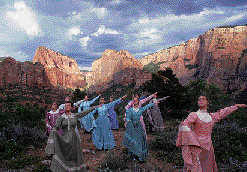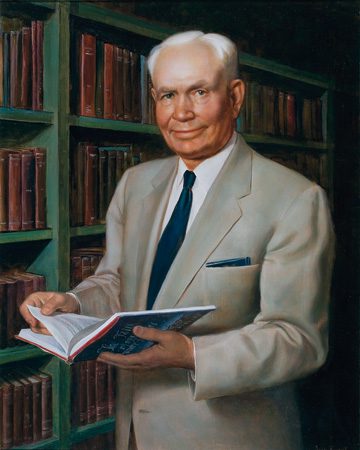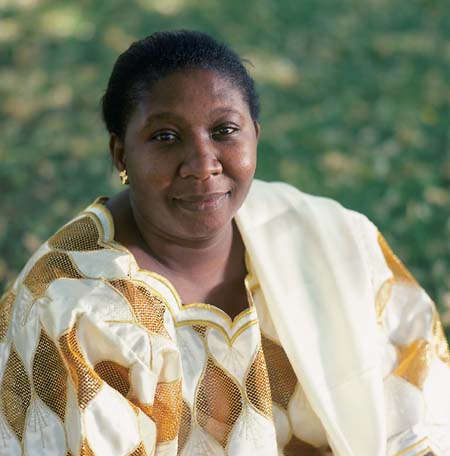By Jeff McClellan
Along about the third week of July, the area around the Harman Building experienced a transformation. It began with a few logs in the Deseret Towers (DT) parking lot. Then leafy tree branches appeared on the baseball backstop on the northeast corner of DT Field. Soon there were cabins being constructed and tepees rising as everything from the baseball backstop to the Bean Museum parking lot turned into a giant Pioneer Rendezvous.
The Rendezvous was sponsored by the LDS Church to celebrate the sesquicentennial of the Mormon pioneers’ arrival in the Salt Lake Valley. And although Provo is a couple of days by wagon from Salt Lake’s Emigration Canyon, BYU campus was chosen as the host of the event. BYU’s involvement, however, extended beyond merely hosting. Volunteerism emanated from all corners of campus as BYU employees and departments became involved in the Rendezvous as well as the Sesquicentennial Spectacular that erupted in Cougar Stadium on July 24 and 25.
Alton Wade, BYU’s student life vice president, recalls meeting with President Merrill J. Bateman when the Church requested to use BYU campus for the celebration. The two discussed it, he said, and “agreed we should throw heart and soul into it.” Heart and soul and tables and chairs and computers and scenery and stadiums and parking lots. The list goes on. There were hamburgers and drinks, tents and poles, televisions and VCRs, and a football field. There were grounds crews and technical people, computer programmers and cooks, cashiers and event staff–hundreds of people and thousands of hours.
The Rendezvous alone was Herculean in size, drawing an estimated more than 100,000 visitors in two days. In the Bean Museum parking lot, a huge camouflage net tent shaded the Chuck Wagon–some 116 tables and 928 chairs where BYU dining services handed out more than 50,000 meals. On the Harman Building patio, the BYU scene shop built a frontier town facade, behind which the BYU Bookstore sold pioneer products. Inside the Harman Building, 80 computers and a software program written for the event by two BYU professors spit out participants’ pioneer ancestry, including stories and photos. There was also an Indian tepee village, a pioneer village, and demonstrations on printing, weaving, bread making, and more. And the north DT parking lot became the plains–complete with sage brush and juniper trees–where modern pioneers pulled handcarts and witnessed various aspects of trail life.
Rendezvous co-chair Ann Seamons raved about BYU’s willingness to help. For example, she said, when Rendezvous planners decided to import rocks to the DT parking lot so handcart pioneers could experience rough terrain, BYU grounds manager Roy Peterman responded, “Rocks! Heck, I’ll give you a river!” And so the grounds crew tapped into the sprinkling system, producing not only a river but also rain to add to the rocks and the sand on the DT plains.
Sesquicentennial organizers are singing BYU’s praises left and right these days. Janielle Christensen, producer of the Spectacular and artistic director for BYU’s Living Legends (formerly the Lamanite Generation), used the word wonderful more than once in describing the cooperation she received from campus entities. “The really wonderful thing about BYU’s involvement was we had President Bateman’s full support,” she said.
That full support extended across campus, she said, allowing the Church to use the 65,000-seat stadium (which sold out both nights) without the usual rental fee and causing the stadium turf supervisors to permit their football grass to be impressed upon by four stages, four dancing water fountains, 32 speaker clusters, 130 automatic light fixtures, 14 handcarts, a wagon train, multiple horse hoov
es, and more than 12,000 human feet, two of which belonged to LDS Church President Gordon B. Hinckley.
“This becomes a great culminating chapter in a long series of chapters,” said President Hinckley of the Spectacular and its role in the sesquicentennial celebration. In addition to the Mormon Tabernacle Choir and the Mormon Youth Chorus and Symphony, the show featured some 500 members and alumni of BYU’s Young Ambassadors, Folk Dancers, and Living Legends. Talents, time, props, scenes, and technical specialties from BYU were all drawn upon to “create a very unique celebration of who we are and how we feel about our ancestors,” Christensen said.
“This truly was a celebration of the Savior,” said Seamons. “It was for the pioneers, but it was because of Him that they came.”

With Zion National Park’s Kolob Canyon as a backdrop, the BYU Dancer’s Company performs “Woman, the Pioneer.” The dance was aired on KBYU as part of the sesquicentennial celebration.
Others at BYU celebrated the sesquicentennial as well. In May, about a dozen members of the BYU Dancer’s Company traveled to various Utah landscapes where they dressed in pioneer attire. Then, with cameras running, they swayed and twirled to music composed by former Mormon Tabernacle organist Robert Cundick, all in celebration of “Woman, the Pioneer.” Created in 1962 for the Seattle World’s Fair, the dance was first re-created in 1973 by Christine Ollerton, a BYU dance faculty member. It has since been performed many times by BYU dancers, and for the sesquicentennial, it was produced on film to memorialize the sacrifices and faith of Mormon women pioneers.
“Whenever this piece is performed, it stirs emotions and feelings,” Ollerton said. “It is fitting that it is a part of the sesquicentennial, because it deals with the struggles of the pioneers and portrays a universal saga of all women.” The production aired on KBYU in late July.
The struggles of the pioneers were felt perhaps most profoundly by those members of the BYU community who participated in the reenactment of the Mormon pioneer trek across the plains. Five students or recent graduates and one staff member joined the 93-day trek this summer, traveling by handcart, horse, wagon, and foot from Winter Quarters, Neb., to Salt Lake City. Others joined the trek for a day, a weekend, a week, or more.
B.C. Moore, who graduated in April in biochemistry and is beginning a biochemistry graduate program at BYU in September, was among the students who went the whole way. “For the past three years I felt driven, I felt this was something I should do,” Moore said. He said the experience taught him faith and dependence on the Lord.
James Fairbourn, the book repair supervisor at the Harold B. Lee Library, saved up vacation days for two years to be able to join the wagon train. He said the trek helped him appreciate more what his ancestors experienced. “It began with my love for my pioneer ancestors,” said Fairbourn. “They were my heroes and I just wanted to follow in their footsteps and see what it was like.”









